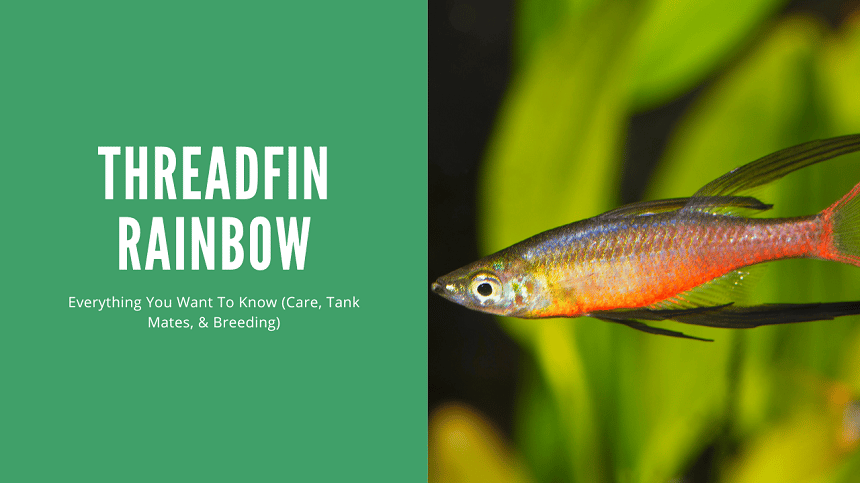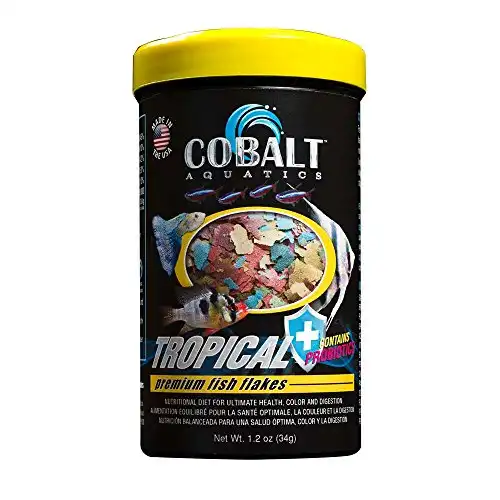Thank you for visiting! By the way… any links on this page that lead to products on Amazon and other stores/partners are affiliate links Aquarium Store Depot earns a commission if you make a purchase.
If you’re a fish tank owner, then you know that it’s important to care for your fish. But did you know that there are different types of fish, and each one requires its own specific type of care? In this blog post, we’ll be discussing the threadfin rainbowfish – an exotic fish that is popular among aquarium enthusiasts. We’ll tell you everything you need to know about these beautiful creatures, from how to care for them to what they eat. So if you’re thinking of adding a threadfin rainbowfish to your tank, read on!
Key Takeaways
- Threadfin rainbowfish are small schooling community fish fit for intermediate to advanced hobbyists.
- These rainbowfish can be challenging to feed due to their small mouths but will thrive in a well-maintained aquarium with stable water parameters.
- Threadfin rainbows readily breed if thickly vegetated areas are provided throughout the aquarium, but fry will need to be removed from the setup to ensure they don’t get eaten.
An Overview
| Scientific Name | Iriatherina werneri |
| Common Names | Threadfin rainbowfish, Featherfin rainbowfish |
| Family | Melanotaeniidae |
| Origin | New Guinea, Northern Australia |
| Diet | Omnivore |
| Care Level | Moderate |
| Activity | Active |
| Lifespan | 3 to 5 years |
| Temperament | Peaceful |
| Tank Level | Middle |
| Minimum Tank Size | 20 Gallons |
| Temperature Range | 72 to 82° F |
| Water Hardness | 7 to 10 KH |
| pH Range | 6.0 – 7.2 |
| Filtration/Water Flow | Slow |
| Water Type | Freshwater |
| Breeding | Egg Scatterer |
| Difficulty to Breed | Moderate |
| Compatibility | Community tanks |
| OK, for Planted Tanks? | Yes |
What Are They?
Threadfin rainbowfish are a special type of rainbowfish in the Melanotaeniidae family. They are scientifically known as Iriatherina werneri and are the only species within the genus Iriatherina due to slight differences in fin, ray, and teeth morphology.
As we’ll see, these freshwater rainbowfish come from very exact locations across a few counties. Depending on the environmental conditions in those ecosystems and the area of collection, threadfin rainbowfish appearance will differ between individuals. It is believed that some differences may be so great that there may be distinct species in the Northern Territory, Queensland, and New Guinea.
Origin and Habitat
Threadfin rainbowfish are not a widespread species, though they have been known to travel distances of over 300 miles. These fish are known to occur in the following locations:
- between the Maro/Merauke River and the Fly River on New Guinea’s southern coast
- Bosset Lagoon, Papua New Guinea
- Cape York Peninsula, Queensland, Australia
- Arafura swamp, Northern Territory, Australia
Threadfin rainbows are commonly found in freshwater swamps and wetlands with abundant plant life and algae growth. They are especially found on the shallow margins of these ecosystems hidden away deep in vegetation.
Interestingly, juvenile males and females make their homes in these shallows while mature males claim territories in more open water. When ready, males will approach the shore and pick a female of their liking. They will then spawn in the nearby vegetation.
Appearance
Threadfin rainbowfish don’t quite look like most rainbowfish or any other species of freshwater fish for that matter. In fact, these fish don’t even look like each other!

Threadfin rainbowfish have very specific appearances based on their area of collection. Water chemistry, like acidity, hardness, and turbidity, can all affect how colors display on any individual fish.
In general, these fish have very streamlined, torpedo-shaped bodies. They get their threadfin or featherfin common name from their very thin and elongated second dorsal fins as well as their ornate pelvic and anal fins. These fins have an extremely delicate appearance, looking like streamers that follow the flow of the fish. These fins are longer and more colorful in male threadfin rainbows, but females can have impressive ones too.
Color can vary significantly from fish to fish. Most times, the body is green or silver with yellow undertones; darker lateral stripes may sometimes be present. An even greater variation comes in their elongated fins, especially in the males. These are known to come in blues, pinks, yellows, oranges, reds, and natural tones.
How Big Do They Get?
Threadfin rainbows are small fish, growing between 2 to 3 inches at mature size. Males are typically larger, more colorful, and with longer fins.
How Long Do They Live?
Threadfin rainbowfish are surprisingly expensive to buy. On average, these fish sell for about $5 to $15 each. When kept in a school, this can definitely become quite an investment.
That being said, these fish don’t live a particularly long time either. On average, they live for about 3 to 5 years. The good part is that they’re relatively easy to spawn given some prior fish breeding knowledge.
Care
Threadfin rainbows are good fish for intermediate to advanced fish keepers. These fish act like normal freshwater schooling fish, but have some specific spacial and dietary needs. It should also be noted that some hobbyists only like keeping threadfin rainbows in a species-only aquarium setup.
Here’s how to make sure your threadfin rainbowfish stay happy and healthy!
Aquarium Setup
Threadfin rainbowfish enjoy aquarium setups that replicate the conditions of their natural habitat. This means slow-flowing waters, dense vegetation, a school for protection, and plenty of available food.
The ideal threadfin rainbowfish aquarium would be a long, heavily planted aquarium, including floating plants to help provide additional shelter and to diffuse high lighting. A dark gravel or sand substrate may be used to encourage fish to show brighter colors. Filtration should be efficient while water flow should be minimal. These are relatively delicate fish that won’t be able to swim against an overly harsh current.
Threadfin rainbowfish are not the hardiest species of rainbowfish or freshwater fish in general. They need a mature tank with lots of available algae and micro foods that they can pick at with their tiny mouths. They are also susceptible to incorrect and poor water quality, making regular tank maintenance and husbandry an absolute must.
Last but not least, it is imperative to keep these fish in a covered aquarium. Threadfin rainbows can easily jump several inches out of the water and you don’t want to come home to find your fish dead on the floor. Remember, jumping out of the water can also be a sign of stress or poor water quality.
Tank Size
There is some discussion as to which tank size is best for threadfin rainbows. These are small schooling fish that like to stay around the middle and top sections of the aquarium. Most other freshwater fish only need a 10 gallon to thrive, but the threadfin rainbow is a little different.
The minimum tank size recommended for a school of threadfin rainbows is a 20 gallon long aquarium. Anything smaller or shorter than this will limit your fish’s activity level, subsequently affecting other aspects of their health.
Though these fish are small, you shouldn’t be fooled into thinking they’re another nano fish. Instead, threadfin rainbows need room to swim.
Filtration and Aeration
Threadfin rainbowfish need good filtration. They can be sensitive to imperfect and wavering water parameters, so they do best in a mature setup with regular aquarium maintenance. The trick to keeping these fish happy and healthy is by having good filtration but a slow water flow.
For The Professional Aquascaper
With an easy to remove prefilter chamber and intregrated heater chamber, this is the most advanced canister filter you can buy today. German engineered and aquascaper approved!
Because of this, it’s recommended to use a hang-on-the-back filter or sponge filter that only agitates the surface of the water. A canister filter may have an overpowering return rate, though this can be lessened through valves or another DIY solution.
Additional aeration is usually not necessary as these fish are often kept with live plants that keep the aquarium water oxygenated. If keeping a large amount of fish, then it’s recommended to add an air stone.
Lighting
Threadfin rainbowfish can be kept under most lights and lighting intensities. Hobbyists have found that they prefer slightly dimmed conditions, but this doesn’t necessarily mean that the light fixture needs to be compromised.
Instead, there are ways to dim the lighting in the aquarium by using botanical tannins or keeping floating plants. Tannins allow light to penetrate the water column while also providing an immunity boost to fish. Floating plants, like floating lily pads, could cast too much shadow on the plants below, so overgrowth will need to be maintained.
Aquatic Plants and Decorations
Threadfin rainbows love a planted aquarium! They are generally bold, active fish that will feel even more encouraged to swim in the front of the aquarium if they know plenty of shelter is around.
Remember, these fish live in dense vegetation in their natural habitat and it’s best to replicate those conditions as best as possible. These plants do not need to be challenging species as threadfins will appreciate density over selection.
One of the benefits of keeping threadfin rainbows is that they’ve been known to eat some pest algae. That being said, they should never be used as a solution to algae problems.
Tank Maintenance
As mentioned before, threadfin rainbows are relatively sensitive to imperfect water conditions. If you are a new hobbyist, then other rainbowfish, like the larger Boesemani rainbowfish (Melanotaenia boesemani), might be more suitable.
To keep your threadfin rainbow happy and healthy, it’s recommended to do 25% water changes every week or every other week depending on the bioload; the aquarium filter media should also be cleaned at least once a month.
The required maintenance for a threadfin rainbowfish aquarium will vary greatly depending on the tank size and number of plants. More plants mean that more nutrients are naturally used and exported. In some cases, additional fertilizers might be necessary to keep up with nutrient demand.
Substrate
These freshwater fish can be kept on either a sand or gravel substrate, though sand is preferred in most cases. This is because their long fins can get caught in gravel, which could lead to infection. However, a fully healthy fish should be able to avoid this from happening.
A key decision to make when choosing a substrate for threadfin rainbows is color. A darker substrate can encourage these fish to show their best bright colors.
Community Tank Mates
On paper, threadfin rainbowfish are the perfect schooling species for a planted community tank. On the contrary, most hobbyists like to keep these fish in a species-only setup. Why?
The main difficulty of keeping threadfin rainbowfish is accommodating for their small mouth. Inexperienced hobbyists may not know how to keep these fish fed apart from the other species in the tank. By using some feeding techniques and picking the right tank mates, threadfin rainbowfish can easily be kept in a community setup.
Here are some of the best community tank mates for threadfin rainbowfish:
- Corydoras
- Small tetras
- Small rasboras
- Otocinclus
- Other small rainbowfish
Compatible rainbowfish species include the forktail blue-eye rainbowfish (Pseudomugil furcatus) and the dwarf neon rainbowfish (Melanotaenia praecox).
It is also important to consider that threadfin rainbowfish are schooling fish and should be kept in groups of at least 6 or more. One male should be kept for about every 3 to 4 females; males can be very incessant about spawning and multiple females will help distribute harassment. In smaller aquariums, it can be difficult to keep multiple males as they will frequently spar with each other to assert dominance.
Poor Tank mates
Poor threadfin rainbowfish tankmates are ones that are either less active or more active. A little confusing, right?
The problem is that threadfin rainbows are peaceful fish that get along with many fish, but they’re very active and can stress out more docile species. On the other hand, overly active fish can also stress out these rainbows and outcompete them when the time comes to eat.
Fin nippers like Tiger Barbs should also be avoided due to their extended fins.
Food and Diet
So how do you feed these fish with incredibly tiny mouths? By feeding the right kinds of foods with the right techniques.
These fish should be given a variety of live, freeze-dried, and frozen foods. They are active fish with a high metabolism and should be fed at least two times a day. They will enjoy brine shrimp, bloodworms, and mosquito larvae, though these foods can become expensive over time. High-quality crushed flake foods or pellet foods should be the staple of the diet.
Best Tropical Fish Flake Food
Cobalt offers a premium level flake food with probiotics. A color enhancing formula that works great for all tropical fish
To ensure that your fish are getting enough food, it’s important to create a routine. This includes feeding your fish at the same times and in the same areas of the tank every day.
A common way to feed sensitive fish is by feeding them their preferred foods away from the rest of the fish in the aquarium; feed rainbowfish on one side of the aquarium and all the other fish on the other side.
If you find that your fish are being outcompeted for food, then you may need to remove the more aggressive species.
Breeding
Breeding threadfin rainbowfish is pretty easy. If a male and female are present in the aquarium, then it’s likely they’ll breed on their own, especially if a spawning medium, like Java moss (Vesicularia dubyana), is available in the aquarium.
For more controlled breeding, a male fish and 3 to 4 female fish should be moved to a breeding tank. When ready, the male will display intense colors and move his fins to entice the females. When she is ready, she will lay an egg near a densely planted area or where a spawning mop is provided.
Once the eggs have been distributed and fertilized, the adults should be removed from the tank as the adults are egg scatterers and will eat their own eggs and fry. The eggs will hatch in a few days. The fry are very small and delicate and need to be given the smallest microfauna until ready to accept other prepared foods or smaller live foods like baby brine shrimp.
Where To Buy
You can buy Threadfin Rainbowfish at local specialty fish stores. General pet stores will generally not carry this fish. If you cannot find a reputable local fish store, consider purchasing the fish from an online dealer. I highly recommend purchasing from Flip Aquatics. You can use my promo code ASDFLIPPROMO for an additional discount at checkout.
A stand-out rainbowfish. Small long bodies with long fins. They are one of the smallest Rainbowfish available
FAQS
Are They Good Community Fish?
Threadfin rainbowfish are good community fish when the aquarium is set up with them in mind. These fish need room to swim and can stress out slower species. They also need to be able to outcompete more active species when it comes to feeding times.
Are They Aggressive?
Threadfin rainbowfish are not aggressive towards other fish, but males can be especially aggressive towards each other due to spawning. For this reason, it’s recommended to keep only one male for every small group of females to decrease these aggressive interactions.
Are They Schooling Fish?
Yes, threadfin rainbowfish are schooling fish and will not do well when kept by themselves. Ideally, one male should be kept for every 3 to 4 females. In total, a school should be at least 6 fish.
Can They Live With Shrimp?
Yes! Threadfin rainbowfish are a great addition to a freshwater shrimp aquarium. These fish have very tiny mouths, which makes it near impossible for them to eat adult shrimp; there is a small chance that they’ll eat shrimp fry, but usually, threadfins are more interested in other available algae and microscopic foods.
Final Thoughts
Threadfin rainbowfish have been in the aquarium hobby for a long time and are often overlooked. They are small fish with small mouths that need some consideration when it comes to feeding and nutrition. However, they readily breed and thrive in a well-planted aquarium. Subscribe to our YouTube channel if you want to see new video content or enter a comment in below and start a conversation.
- About the Author
- Latest Posts
I’m thrilled that you found Aquarium Store Depot! Here you’ll find information on fish, aquariums, and all things aquatics related. I’m a hobbyist (being doing this since I was 11) and here to help other hobbyists thrive with their aquariums! I adhere to a high quality Editorial Process and Review products with real life field usage and practical analysis.








